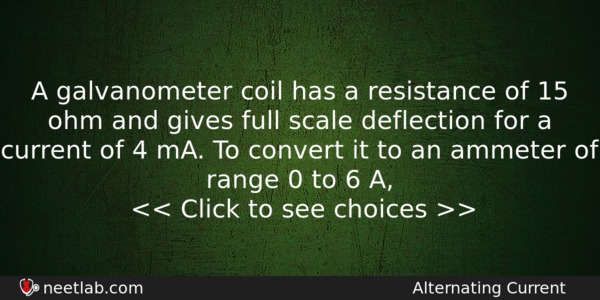| ⇦ | 
| ⇨ |
A galvanometer coil has a resistance of 15 ohm and gives full scale deflection for a current of 4 mA. To convert it to an ammeter of range 0 to 6 A,
Options
(a) 10 mΩ resistance is to be connected in parallel to the galvanometer
(b) 10 mΩ resistance is to be connected in series with the galvanometer
(c) 0.1 Ω resistance is to be connected in parallel to the galvanometer
(d) 0.1 Ω resistance is to be connected in series with the galvanometer
Correct Answer:
10 mΩ resistance is to be connected in parallel to the galvanometer
Explanation:
No explanation available. Be the first to write the explanation for this question by commenting below.
Related Questions: - The nuclear fusion reaction between deutrium and tritium takes place
- Water drops fall from a top on the floor 5 m below at regular intervals
- The vector sum of two forces is perpendicular to their vector difference. In that case,
- An electric kettle has two heating elements. One brings it to boil in ten minutes
- The frequency of a light wave in a material is 2 x 10¹⁴ Hz and wavelength is 5000Å.
Topics: Alternating Current
(96)
Subject: Physics
(2479)
Important MCQs Based on Medical Entrance Examinations To Improve Your NEET Score
- The nuclear fusion reaction between deutrium and tritium takes place
- Water drops fall from a top on the floor 5 m below at regular intervals
- The vector sum of two forces is perpendicular to their vector difference. In that case,
- An electric kettle has two heating elements. One brings it to boil in ten minutes
- The frequency of a light wave in a material is 2 x 10¹⁴ Hz and wavelength is 5000Å.
Topics: Alternating Current (96)
Subject: Physics (2479)
Important MCQs Based on Medical Entrance Examinations To Improve Your NEET Score
18000+ students are using NEETLab to improve their score. What about you?
Solve Previous Year MCQs, Mock Tests, Topicwise Practice Tests, Identify Weak Topics, Formula Flash cards and much more is available in NEETLab Android App to improve your NEET score.
Share this page with your friends

Given :-
G=15ohm Ig=4mA =0.004A.
I=6A. A shunt resistor of resistance S is to be connected in parallel with the galvanometer to convert it into an ammeter . The value of S is given by – S = Ig×G / I-Ig.
= 0.004 ×15 / 6-0.004. S= 0.06/5.996 = 0.01ohm =10m ohm.